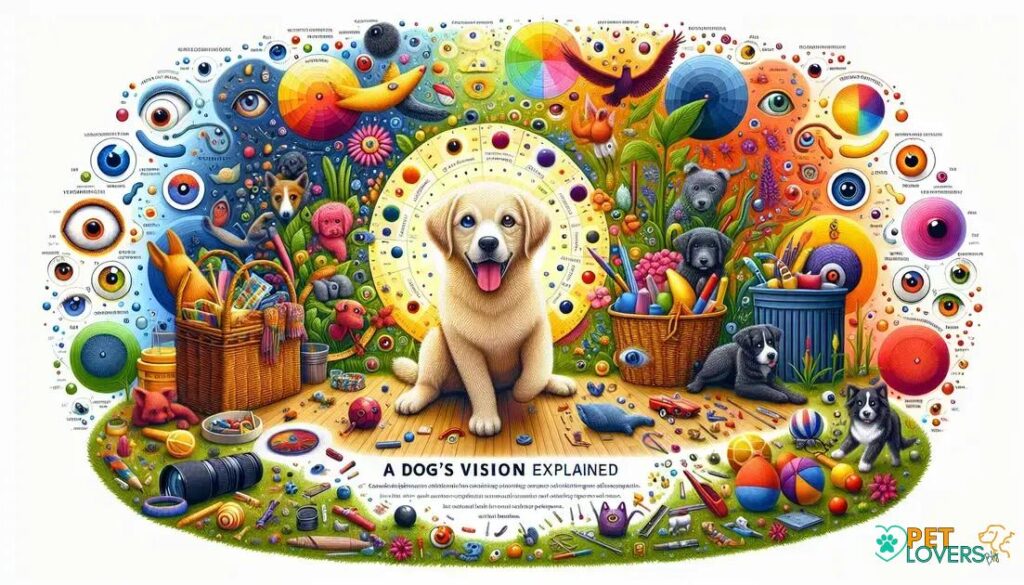Dogs perceive colors primarily in shades of blue and yellow, while they have difficulty distinguishing reds and greens. This limited color vision contrasts with humans, who can see a wider range of colors. To enhance playtime and interaction, dog owners should choose toys in blue or yellow, aligning with their pets’ visual preferences.
Can dogs see colors? This captivating question has puzzled pet owners for years.
While dogs see the world differently than we do, their vision has its unique charm.
Understanding canine vision is crucial for every dog owner, as it influences everything from playtime activities to their responses to training.
In this article, we’ll uncover the truth behind canine color perception and what it means for our furry friends.
Understanding Dog´s Vision
Understanding Dog´s Vision is essential for dog owners. Dogs perceive their environment differently than humans do. While we rely heavily on color, dogs’ vision is more focused on movement and brightness. Their eyes have a greater number of rod cells, which allow them to detect motion in low light better than we can. This is why dogs may seem to react quickly to things we cannot see!
Unlike humans, who have three types of color receptors, dogs have only two. They see primarily in shades of blue and yellow, but they struggle to distinguish between reds and greens. This limited color perception means that a bright red toy might appear grayish to them. When choosing toys, consider those that are primarily blue or yellow, as these colors stand out more to your furry friend.
Understanding how dogs see the world not only enhances our appreciation of their abilities but also helps us create a more engaging environment for them. Remember, their world may not look like ours, but it is still vibrant and full of life!
The Science Behind Color Perception in Dogs
The science behind color perception in dogs is fascinating and reveals a world that is far different from our own. Dogs have dichromatic vision, meaning they possess two types of color receptors in their eyes, while humans have three. This means that dogs primarily see colors in shades of blue and yellow, with the inability to differentiate reds and greens. As a result, a bright red ball may appear duller or even gray to them.
Researchers believe that this color perception evolved to enhance dogs’ abilities as hunters and scavengers, where movement detection is more crucial than color differentiation. They rely more on brightness and contrast than on color. In essence, dogs are more likely to notice a moving object than a stationary one, regardless of its color.
By understanding the science behind how dogs perceive color, pet owners can make informed decisions when it comes to choosing toys and training techniques. Toys that are blue or yellow are more likely to attract a dog’s attention and ensure that playtime is engaging and enjoyable for them.
Common Myths About Dogs and Color
Many myths surround dogs’ abilities to see color, leading to misconceptions among dog owners.
One common myth is that dogs see only in black and white. In reality, dogs can see colors, but their spectrum is limited compared to humans. They mainly perceive blue and yellow, and as a result, red and green appear less distinct to them.
Another myth is that dogs can see better in the dark than humans. While dogs do have superior night vision due to a higher number of rod cells, they still cannot see in complete darkness. Their eyes are adapted for low-light conditions, allowing them to detect movement better in dim environments.
Understanding Dogs’ Vision
Some believe that dogs only care about the movement of an object and do not notice colors at all. While movement does capture their attention, the colors blue and yellow are attractive to them, and they can differentiate these colors from others.
It’s important to debunk these myths to better understand our dogs and to ensure we provide them with toys and activities that suit their vision capabilities. Awareness of their unique perception can enhance our bond with them and their overall well-being.
How Dogs’ Color Vision Differs from Humans
Dogs’ color vision is distinct from that of humans, primarily due to the number of cone cells in their eyes. Humans have three types of cone cells, allowing us to see a wide variety of colors, while dogs only have two. This means that dogs primarily see the world in shades of blue and yellow. They struggle to distinguish between reds and greens, which appear grayish to them.
This difference in color perception affects how dogs interact with their environment. For example, toys that are bright blue or yellow stand out more to them, while red toys may not capture their interest as effectively. Furthermore, dogs rely on brightness and contrast to navigate and understand their surroundings, not just color.
Understanding these differences can help pet owners make better choices in the toys and activities they provide. By selecting items in the color spectrum that dogs can see more vibrantly, we can create a more enjoyable experience for our furry friends. Knowing how dogs perceive color also allows for improved training methods, better bonding, and a more enriching environment for our canine companions.
Tips for Choosing Toys Based on Color Perception
When choosing toys for your dog, consider their color perception to ensure maximum engagement. Since dogs primarily see in shades of blue and yellow, it is beneficial to select toys that are bright in these colors.
For example, blue or yellow balls are easily visible and can keep your dog interested during playtime. Avoid red or green toys, as these colors can appear grayish and may not capture your dog’s attention.
Also, look for toys that incorporate patterns or textures, as these can provide the visual stimulation they need. Interactive toys that create movement or noise can also attract their interest.
Lastly, rotating toys regularly can keep playtime fresh and exciting for your dog. By considering color perception when selecting toys, you create a fun and engaging environment for your furry friend!
Conclusion
Understanding how dogs perceive colors and the myths surrounding their vision is vital for dog owners.
By knowing that dogs see primarily in blue and yellow, we can choose toys that engage their interest and cater to their visual capabilities.
It is essential to select toys that stand out in their color spectrum, focusing on bright hues that dogs can see more clearly.
Additionally, acknowledging the differences between canine and human vision helps create a better environment for our pets.
By making informed choices, we can enhance our dogs’ playtime experiences and enrich their lives.
FAQ – Frequently Asked Questions About Dog Color Perception
Can dogs see colors like humans do?
Dogs primarily see in shades of blue and yellow, but they struggle with reds and greens.
Do dogs see only in black and white?
No, this is a common myth. Dogs can see colors, but their color vision is limited compared to humans.
What colors are best for dog toys?
Bright blue and yellow toys are most visible to dogs and will keep their interest.
How does a dog’s vision differ from human vision?
Dogs have fewer cone cells than humans, which makes their color perception less broad.
Do dogs have better night vision than humans?
Yes, dogs have better night vision but cannot see in complete darkness; their eyes can detect movement in low light.
How can I choose toys that my dog can see better?
Opt for toys in blue or yellow colors and consider those with patterns or textures for added stimulation.

